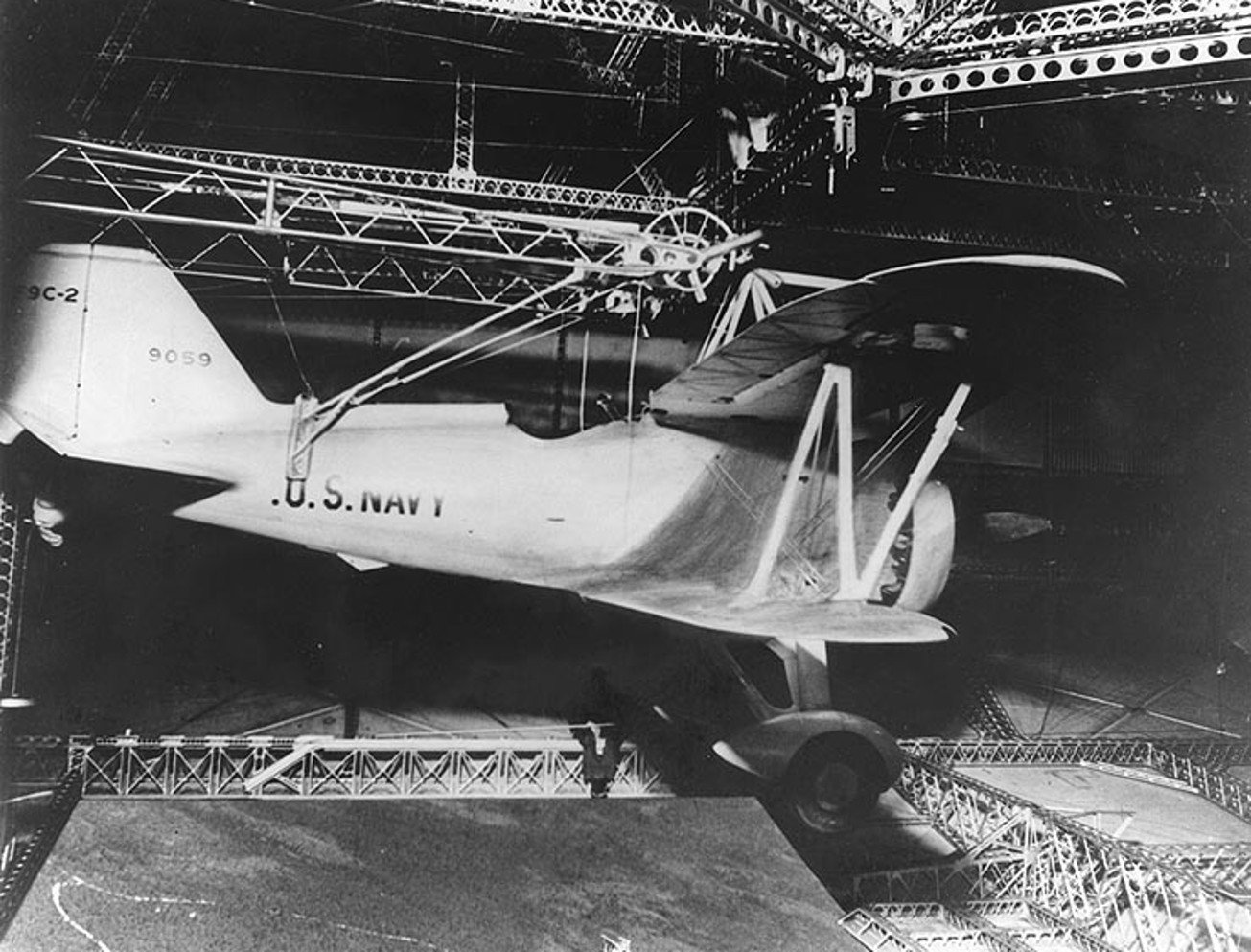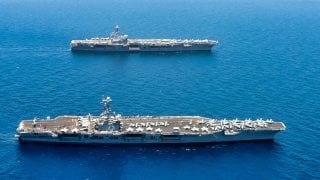The U.S. Navy Built a Real 'Flying' Aircraft Carrier
The Akron-class airships, Akron and Macon, represented the pinnacle of rigid airship design and were the U.S. Navy's only flying aircraft carriers. Built by Goodyear-Zeppelin in the 1930s, these helium-filled airships carried aircraft for reconnaissance and had advanced features like internal engines for reduced drag.
What You Need to Know: The Akron-class airships, Akron and Macon, represented the pinnacle of rigid airship design and were the U.S. Navy's only flying aircraft carriers. Built by Goodyear-Zeppelin in the 1930s, these helium-filled airships carried aircraft for reconnaissance and had advanced features like internal engines for reduced drag.

-While initially promising, both ships were lost in storms (Akron in 1933, Macon in 1935), resulting in significant casualties and diminished enthusiasm for airships.
-The Navy shifted focus to fixed-wing aircraft, which proved more effective and economical. Despite their potential, the Akron-class remains a fascinating but fleeting chapter in aviation history.
The U.S. Navy’s Flying Aircraft Carriers: The Rise and Fall of the Akron-Class Airships
On December 17th, 1903, the Wright brothers made history when they completed the first heavier-than-air flight. Although this was a remarkable accomplishment and led to the development of all modern aircraft, it was not the first time man had taken to the skies.
Lighter-than-air (LTA) ships had been flying for some decades, and many nations continued to invest in them for a number of years following the invention of heavier-than-air powered flight. The two Akron-class airships - what some call the flying aircraft carriers - of the U.S. Navy represented the pinnacle of LTA design, and they heralded the age of airships worldwide.
Airships, Dirigibles, Blimps, and Zeppelins to Flying Aircraft Carriers
While the terms are often used interchangeably, airships, dirigibles, blimps, and zeppelins describe different vessels. An airship or dirigible is any LTA craft that is powered and steerable as opposed to being at the mercy of wind currents like a hot air balloon. Blimps are basically powered balloons. The lifting gas inside them enables them to maintain their shape. A rigid airship uses an internal frame to maintain its shape and provide a support structure while bladders of lifting gas are installed within the structure. Rigid airships are often called zeppelins, although technically that refers specifically to airships designed and built by the German company Luftschiffbau Zeppelin. Perhaps the most famous of their craft was the passenger liner Hindenburg.
Prior to the First World War, zeppelins were used in civilian flights both for simple sightseeing and as destination flights. At the same time, the German military took note and began investigating their use as scouts or bombers. When the war became deadlocked in 1915, zeppelins actually participated in the little known “First London Blitz,” bombing cities in the United Kingdom. As the war progressed, British defense solidified and zeppelins’ weaknesses were revealed leading to the loss of 77 out of 115 airships which participated in the raids. Nevertheless, there was still significant interest in using rigid airships as tools of war.
The Origins of the Akron-Class Flying Aircraft Carriers
Akron-class ships were full rigid airships built in a joint venture by the Goodyear company and Zeppelin after WWI. At the close of the war, the Navy in particular was interested in getting its hands on an airship after seeing one that had been forced down during a raid over the UK. Initial plans called for two German craft to be turned over to the U.S. as reparations; however their crews destroyed them before the transfer could take place.

The U.S. did eventually end up with two airships built by Germany, USS Shenandoah and Los Angeles. The moderate success of these two craft, despite the loss of Shenandoah, led the Navy to solicit bids for two U.S.-built airships. In 1928, the Goodyear-Zeppelin Corporation won the contract to produce the two ships which would make up the Akron class.
An Overview of the Airship Design
German engineer Karl Arnstein traveled to the U.S. to work with the Goodyear company on the design for the new airships. The result was a 785-foot craft capable of cruising at 55 knots, with a top speed of nearly 70 knots. Its internal structure differed from contemporaries in that it featured a few reinforced structural rings to distribute loads, while the remainder served to simply maintain its shape. Furthermore, instead of a single keel, three keels ran the length of the ship. One along the top supported the gas cells and two more near the bottom held crew compartments and engine spaces. Another deviation was the use of helium instead of hydrogen as the lifting gas. Hydrogen’s explosive nature had been put on display in the Hindenburg incident, and the Navy wanted a more stable solution. Helium was quite expensive and difficult to produce, but it provided an immediate benefit: The Akrons’ eight engines were housed internally, greatly reducing drag and enabling their high top speed.
Perhaps the most striking new feature of the class was the addition of an aircraft hangar within the ship. The Macon could carry up to five aircraft, while design constraints limited the Akron to three. These planes were launched and recovered using a sky hook. When launching, they were lowered into the slipstream, where the pilot started the engine, released the hook, and dropped away. On recovery, the process was reversed, with the pilot flying onto the hook before shutting down.
Operational History of the Akron-Class:
The first of the two airships, Akron, was commissioned in 1931. She spent the next two years refining procedures for scouting enemy fleets. It was during this time the idea of using her as a flying aircraft carrier came into being. While the expectation of planners was that the embarked fighters would serve to protect the mother ship from attacks, several exercises dispelled this notion.
Hostile aircraft and anti-aircraft fire was thought to be far too devastating for the airships to withstand, so the mission of her airwing was changed to that of scouting. At the time, this gave the ship unprecedented scouting range. By replacing the airplanes’ landing gear with fuel tanks, they achieved a range of 200 miles. Combined with the high speed of the airship relative to surface vessels, there was potential for a very real use for the Akrons. Macon was commissioned two years later, in 1933. She undertook her first flight just a few short weeks after the tragic loss of Akron. She picked up the baton where the Akron left off, participating in fleet exercises and refining scouting tactics. Perhaps her most memorable excursion was an endurance flight over the Pacific where she successfully located and tracked the cruiser USS Houston, which was ferrying President Roosevelt to vacation in Hawaii.

Losses and Ramifications:
Akron was lost in April of 1933 after flying into a storm in the North Atlantic. Tragically, due to the rough sea state and the lack of lifejackets, 73 of 76 men aboard perished. Among them was Rear Admiral William Moffett, an early and vocal proponent of the airship program. Without his support, the appetite for airship investment began swiftly to decline. Macon was lost in similar conditions off the coast of Monterey in February, 1935.
Upon encountering rough weather, she suffered a structural failure which damaged her gas cells. Luckily, she settled into the water quite gradually and nearly all of her crew survived - only two were killed. The introduction of life jackets following the Akron disaster doubtless contributed. Ultimately, the Navy would not resurrect its large, rigid airship program.
Although there was some enthusiasm, including a proposed $16.75 million in funding, President Roosevelt instead instructed planners to focus on long range patrol planes. Leaps in fixed wing technology gave aircraft much greater range and survivability while simultaneously costing far less.
Today, the flying aircraft carriers Akron and Macon are a little known chapter in naval aviation history. While history carried on, they beg the question, what could have been?
About the Author: Maya Carlin
Maya Carlin, National Security Writer with The National Interest, is an analyst with the Center for Security Policy and a former Anna Sobol Levy Fellow at IDC Herzliya in Israel. She has by-lines in many publications, including The National Interest, Jerusalem Post, and Times of Israel. You can follow her on Twitter: @MayaCarlin.
All images are Creative Commons and/or Shutterstock.


